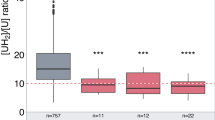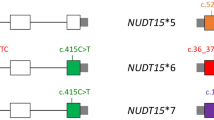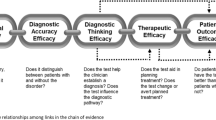Abstract
Phenotypic rather than genotypic tests remain the gold standard for diagnosing glucose-6-phosphate dehydrogenase (G6PD) deficiency. However, with increasing use of genomic arrays and whole exome or genome sequencing, G6PD genetic data are increasingly available. We examined the utility of G6PD genetic data in patients with hematologic malignancies and the association of G6PD genotype and phenotype with rasburicase-induced methemoglobinemia. We analyzed G6PD activity for 990 patients. Genotype data were available from the Affymetrix DMET array (n = 379), whole exome sequencing (n = 374), and/or the Illumina exome array (n = 634) for 645 patients. Medical records of 341 patients with methemoglobin measures were assessed for the administration of rasburicase. We observed 5 non-synonymous SNPs, 4 of which were known to be associated with deficient G6PD activity (WHO Class I–III). Genotyping 367 males resulted in a positive predictive value of 81.8% (47.8–96.8%), and two males with a Class I-III allele having normal activity both received a red blood cell transfusion prior to the activity assay. However, genotyping males had only 39.1% (20.5–61.2%) sensitivity. Two of the 12 heterozygous females had deficient G6PD activity. Rasburicase-induced methemoglobinemia occurred in 6 patients, 5 of whom had at least one Class I–III allele, despite 2 of these having normal G6PD activity. We conclude that although an apparent nondeficient genotype does not necessarily imply a normal phenotype, a deficient genotype result indicates a deficient phenotype in those without transfusions, and may be a useful adjuct to phenotype to prevent adverse drug reactions.
This is a preview of subscription content, access via your institution
Access options
Subscribe to this journal
Receive 6 print issues and online access
$259.00 per year
only $43.17 per issue
Buy this article
- Purchase on Springer Link
- Instant access to full article PDF
Prices may be subject to local taxes which are calculated during checkout






Similar content being viewed by others
References
Luzzatto L, Nannelli C, Notaro R. Glucose-6-phosphate dehydrogenase deficiency. Hematol Oncol Clin North Am. 2016;30:373–93.
Pandolfi PP, Sonati F, Rivi R, Mason P, Grosveld F, Luzzatto L. Targeted disruption of the housekeeping gene encoding glucose 6-phosphate dehydrogenase (G6PD): G6PD is dispensable for pentose synthesis but essential for defense against oxidative stress. EMBO J. 1995;14:5209–15.
Sivilotti ML. Oxidant stress and haemolysis of the human erythrocyte. Toxicol Rev. 2004;23:169–88.
Mason PJ, Bautista JM, Gilsanz F. G6PD deficiency: the genotype-phenotype association. Blood Rev. 2007;21:267–83.
McDonagh EM, Bautista JM, Youngster I, Altman RB, Klein TE. PharmGKB summary: methylene blue pathway. Pharm Genom. 2013;23:498–508.
Relling MV, McDonagh EM, Chang T, Caudle KE, McLeod HL, Haidar CE, et al. Clinical Pharmacogenetics Implementation Consortium (CPIC) guidelines for rasburicase therapy in the context of G6PD deficiency genotype. Clin Pharmacol Ther. 2014;96:169–74.
Nkhoma ET, Poole C, Vannappagari V, Hall SA, Beutler E. The global prevalence of glucose-6-phosphate dehydrogenase deficiency: a systematic review and meta-analysis. Blood Cells, Mol & Dis. 2009;42:267–78.
Standardization of procedures for the study of glucose-6-phosphate dehydrogenase.. Report of a WHO Scientific Group. World Health Organ Tech Report Ser. 1967;366:1–53.
Domingo GJ, Satyagraha AW, Anvikar A, Baird K, Bancone G, Bansil P, et al. G6PD testing in support of treatment and elimination of malaria: recommendations for evaluation of G6PD tests. Malar J. 2013;12:391.
Abdulrazzaq YM, Micallef R, Qureshi M, Dawodu A, Ahmed I, Khidr A, et al. Diversity in expression of glucose-6-phosphate dehydrogenase deficiency in females. Clin Genet. 1999;55:13–9.
Beutler E, Yeh M, Fairbanks VF. The normal human female as a mosaic of X-chromosome activity: studies using the gene for C-6-PD-deficiency as a marker. Proc Natl Acad Sci USA. 1962;48:9–16.
Nance WE. Genetic tests with a sex-linked marker: glucose-6-phosphate dehydrogenase. Cold Spring Harb Symp Quant Biol. 1964;29:415–25.
Rinaldi A, Filippi G, Siniscalco M. Variability of red cell phenotypes between and within individuals in an unbiased sample of 77 heterozygotes for G6PD deficiency in Sardinia. Am J Hum Genet. 1976;28:496–505.
Luzzatto L, Seneca E. G6PD deficiency: a classic example of pharmacogenetics with on-going clinical implications. Br J Haematol. 2014;164:469–80.
Xia Z, Chen P, Tang N, Yan T, Zhou Y, Xiao Q, et al. Rapid detection of G6PD mutations by multicolor melting curve analysis. Mol Genet Metab. 2016;119:168–73.
Yoshida A, Beutler E, Motulsky AG. Human glucose-6-phosphate dehydrogenase variants. Bull World Health Organ. 1971;45:243–53.
Lin Z, Fontaine JM, Freer DE, Naylor EW. Alternative DNA-based newborn screening for glucose-6-phosphate dehydrogenase deficiency. Mol Genet Metab. 2005;86:212–9.
Fernandez CA, Smith C, Yang W, Lorier R, Crews KR, Kornegay N, et al. Concordance of DMET plus genotyping results with those of orthogonal genotyping methods. Clin Pharmacol Ther. 2012;92:360–5.
Burmester JK, Sedova M, Shapero MH, Mansfield E. DMET microarray technology for pharmacogenomics-based personalized medicine. Methods Mol Biol. 2010;632:99–124.
Grove ML, Yu B, Cochran BJ, Haritunians T, Bis JC, Taylor KD, et al. Best practices and joint calling of the HumanExome BeadChip: the CHARGE Consortium. PLoS ONE. 2013;8:e68095.
Yang W, Wu G, Broeckel U, Smith CA, Turner V, Haidar CE, et al. Comparison of genome sequencing and clinical genotyping for pharmacogenes. Clin Pharmacol Ther. 2016;100:380–8.
Davidson D, Barefield ES, Kattwinkel J, Dudell G, Damask M, Straube R, et al. Inhaled nitric oxide for the early treatment of persistent pulmonary hypertension of the term newborn: a randomized, double-masked, placebo-controlled, dose-response, multicenter study. The I-NO/PPHN Study Group. Pediatrics. 1998;101(3 Pt 1):325–34.
Dellinger RP, Zimmerman JL, Taylor RW, Straube RC, Hauser DL, Criner GJ, et al. Effects of inhaled nitric oxide in patients with acute respiratory distress syndrome: results of a randomized phase II trial. Inhaled nitric oxide in ARDS Study Group. Crit Care Med. 1998;26:15–23.
Mandrell BN, McCormick JN. Dapsone-induced methemoglobinemia in pediatric oncology patients: case examples. J Pediatr Oncol Nurs. 2001;18:224–8.
Plotkin JS, Buell JF, Njoku MJ, Wilson S, Kuo PC, Bartlett ST, et al. Methemoglobinemia associated with dapsone treatment in solid organ transplant recipients: a two-case report and review. Liver Transpl Surg. 1997;3:149–52.
Shahani L, Sattovia S. Acquired methaemoglobinaemia related to phenazopyridine ingestion. BMJ Case Rep. 2012;2012:bcr2012006756.
Green ED, Zimmerman RC, Ghurabi WH, Colohan DP. Phenazopyridine hydrochloride toxicity: a cause of drug-induced methemoglobinemia. JACEP. 1979;8:426–31.
Bayat A, Kosinski RW. Methemoglobinemia in a newborn: a case report. Pediatr Dent. 2011;33:252–4.
Karim A, Ahmed S, Siddiqui R, Mattana J. Methemoglobinemia complicating topical lidocaine used during endoscopic procedures. Am J Med. 2001;111:150–3.
Kawasumi H, Tanaka E, Hoshi D, Kawaguchi Y, Yamanaka H. Methemoglobinemia induced by trimethoprim-sulfamethoxazole in a patient with systemic lupus erythematosus. Intern Med. 2013;52:1741–3.
Carroll TG, Carroll MG. Methemoglobinemia in a pediatric oncology patient receiving sulfamethoxazole/trimethoprim prophylaxis. Am J Case Rep. 2016;17:499–502.
Marks PA, Johnson AB. Relationship between the age of human erythrocytes and their osmotic resistance: a basis for separating young and old erythrocytes. J Clin Invest. 1958;37:1542–8.
Morelli A, Benatti U, Gaetani GF, De Flora A. Biochemical mechanisms of glucose-6-phosphate dehydrogenase deficiency. Proc Natl Acad Sci USA. 1978;75:1979–83.
Beutler E. Glucose-6-phosphate dehydrogenase deficiency. Diagnosis, clinical and genetic implications. Am J Clin Pathol. 1967;47:303–11.
Echler G. Determination of glucose-6-phosphate dehydrogenase levels in red cell preparations. Am J Med Technol. 1983;49:259–62.
Morelli A, Benatti U, Lenzerini L, Sparatore B, Salomino F, Melloni E, et al. The interference of leukocytes and platelets with measurement of clucose-6-phosphate dehydrogenase activity of erythrocytes with low activity variants of the enzyme. Blood. 1981;58:642–4.
Liumbruno G, Bennardello F, Lattanzio A, Piccoli P, Rossetti G. Recommendations for the transfusion of red blood cells. Blood Transfus Trasfus Del Sangue. 2009;7:49–64.
Filosa S, Giacometti N, Wangwei C, De Mattia D, Pagnini D, Alfinito F, et al. Somatic-cell selection is a major determinant of the blood-cell phenotype in heterozygotes for glucose-6-phosphate dehydrogenase mutations causing severe enzyme deficiency. Am J Hum Genet. 1996;59:887–95.
Sanna G, Frau F, De Virgiliis S, Piu P, Bertolino F, Cao A. Glucose-6-phosphate dehydrogenase red blood cell phenotype in GdMediterranean heterozygous females and hemizygous males at birth. Pediatr Res. 1981;15:1443–6.
Au WY, Ma ES, Lam VM, Chan JL, Pang A, Kwong YL. Glucose 6-phosphate dehydrogenase (G6PD) deficiency in elderly Chinese women heterozygous for G6PD variants. Am J Med Genet A. 2004;129a:208–11.
Johnson MK, Clark TD, Njama-Meya D, Rosenthal PJ, Parikh S. Impact of the method of G6PD deficiency assessment on genetic association studies of malaria susceptibility. PLoS ONE. 2009;4:e7246.
Sirdah M, Reading NS, Vankayalapati H, Perkins SL, Shubair ME, Aboud L, et al. Molecular heterogeneity of glucose-6-phosphate dehydrogenase deficiency in Gaza Strip Palestinians. Blood cells Mol Dis. 2012;49:152–8.
Laouini N, Bibi A, Ammar H, Kazdaghli K, Ouali F, Othmani R, et al. Glucose-6-phosphate dehydrogenase deficiency in Tunisia: molecular data and phenotype-genotype association. Mol Biol Rep. 2013;40:851–6.
Sirdah MM, Shubair ME, Al-Kahlout MS, Al-Tayeb JM, Prchal JT, Reading NS. Possible association of 3‵ UTR+357 A>G, IVS11-nt 93 T>C, c.1311 C>T polymorphism with G6PD deficiency. Hematology. 2017;22:370–4.
Dallol A, Banni H, Gari MA, Al-Qahtani MH, Abuzenadeh AM, Al-Sayes F, et al. Five novel glucose-6-phosphate dehydrogenase deficiency haplotypes correlating with disease severity. J Transl Med. 2012;10:199.
Navolanic PM, Pui CH, Larson RA, Bishop MR, Pearce TE, Cairo MS, et al. Elitek-rasburicase: an effective means to prevent and treat hyperuricemia associated with tumor lysis syndrome, a Meeting Report, Dallas, Texas, January 2002. Leukemia. 2003;17:499–514.
Pui CH. Rasburicase: a potent uricolytic agent. Expert Opin Pharmacother. 2002;3:433–42.
Bontant T, Le Garrec S, Avran D, Dauger S. Methaemoglobinaemia in a G6PD-deficient child treated with rasburicase. BMJ Case Rep. 2014;2014:bcr2014204706.
Sonbol MB, Yadav H, Vaidya R, Rana V, Witzig TE. Methemoglobinemia and hemolysis in a patient with G6PD deficiency treated with rasburicase. Am J Hematol. 2013;88:152–4.
Chu CS, Bancone G, Moore KA, Win HH, Thitipanawan N, Po C, et al. Haemolysis in G6PD heterozygous females treated with primaquine for plasmodium vivax malaria: a nested cohort in a trial of radical curative regimens. PLoS Med. 2017;14:e1002224.
Bauters T, Mondelaers V, Robays H, De Wilde H, Benoit Y, De Moerloose B. Methemoglobinemia and hemolytic anemia after rasburicase administration in a child with leukemia. Int J Clin Pharm. 2011;33:58–60.
Kizer N, Martinez E, Powell M. Report of two cases of rasburicase-induced methemoglobinemia. Leuk Lymphoma. 2006;47:2648–50.
Acknowledgements
This study was supported by grants GM 115279 and CA 21765
Author information
Authors and Affiliations
Corresponding author
Ethics declarations
Conflict of interest
The authors declare that they have no conflict of interest.
Electronic supplementary material
Rights and permissions
About this article
Cite this article
Robinson, K.M., Yang, W., Haidar, C.E. et al. Concordance between glucose-6-phosphate dehydrogenase (G6PD) genotype and phenotype and rasburicase use in patients with hematologic malignancies. Pharmacogenomics J 19, 305–314 (2019). https://doi.org/10.1038/s41397-018-0043-3
Received:
Revised:
Accepted:
Published:
Issue Date:
DOI: https://doi.org/10.1038/s41397-018-0043-3
This article is cited by
-
Multiple drugs
Reactions Weekly (2019)



